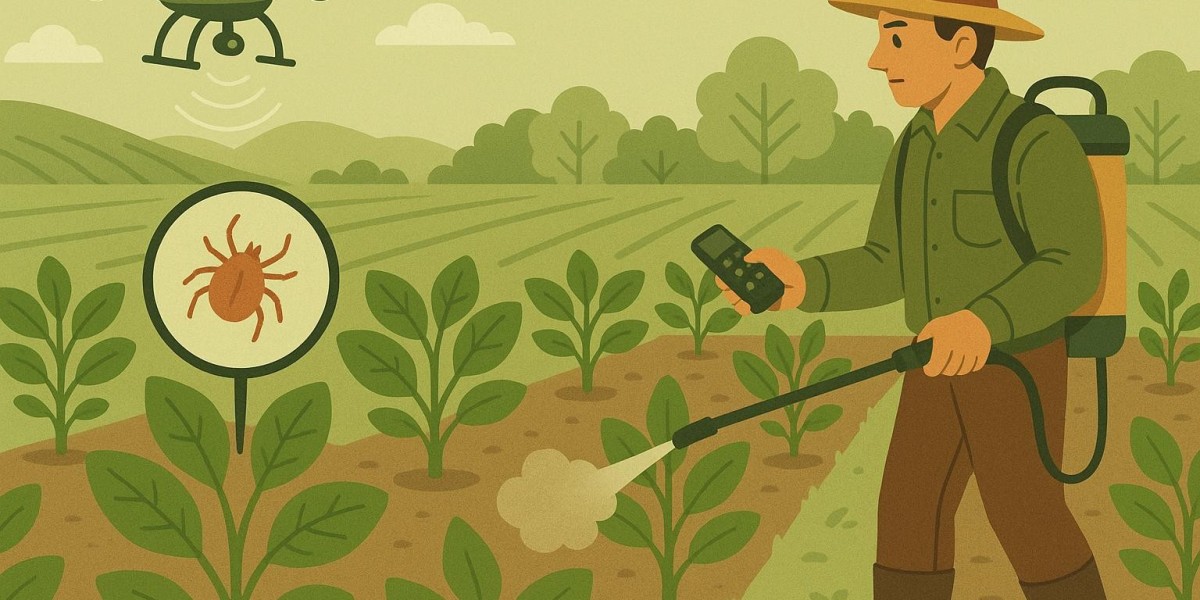Foundations of Natural Pest Control
Understand the Ecosystem First
Before implementing control measures, natural farming emphasises observing the whole ecosystem. What pests are present? What beneficial insects are active? Are there signs of nutrient imbalance that could be making plants more vulnerable?
Healthy plants emit stronger signals—both chemical and electromagnetic—that deter many opportunistic pests. Similarly, diverse farms with wildflowers, hedgerows, and cover crops attract beneficial organisms that prey on pests or outcompete them. Rather than targeting pests in isolation, the framework views their presence as a symptom of imbalance.
In fields where natural predators and parasitoids flourish, studies show a 50–80% reduction in pest outbreaks. The introduction of flowering strips featuring plants such as coriander, fennel, and cosmos has increased beneficial insect activity by up to 35%, particularly lacewings, ladybugs, and parasitoid wasps. Thus, instead of focusing on elimination, the natural farming framework is rooted in equilibrium.
Creating a Pest-Resistant Environment
Crop Diversity and Rotation
Monocultures provide a breeding ground for pests. When the same crop is planted again in the same soil, insect populations can adapt and spread unchecked. Crop rotation and intercropping are encouraged in natural farming to confound pests and disrupt reproduction cycles.
Planting pest-repellent crops like marigold, lemongrass, or basil between rows of susceptible crops
Rotating crops with different families (e.g., legumes followed by brassicas) to avoid host continuity
Polyculture interferes with the chemical and visual signals that pests use to find their host plants. For instance, because of olfactory interference, carrot fly infestation is decreased when onions and carrots are planted together. This effect is further enhanced by using trap crops, like mustard, to draw aphids away from cabbage.
Natural Soil Amendments
Nutrient-poor or compacted soils stress plants, making them more attractive to pests. Adding organic matter and biofertilizers enhances soil structure and fosters microbial networks that promote plant health. Indigenous inputs such as fermented plant juice (FPJ), jeevamrut, and panchagavya nourish plants and fortify their immunity.
The application of beta botanical extract, a substance obtained from plants, to increase plant resistance and prevent pest colonisation is one new input. This natural product improves plant alkaloid profiles that repel herbivorous insects when added early in the growing season. According to recent field research, applying beta botanical extract to tomatoes can reduce the invasion of whiteflies by up to 62% in just 14 days, offering a natural defense without endangering beneficial insects.
Biocontrol Agents and Trap Systems
Predatory Allies in the Field
Natural farming champions the conservation of native predatory insects. Farmers are trained to identify these allies and protect their habitats. These include:
Ground beetles and rove beetles, which feed on cutworms, maggots, and aphids
Parasitic wasps like Trichogramma spp., which lay their eggs inside pest eggs, killing them from within
Selective releases of beneficials, like green lacewings (Chrysoperla carnea), can aid in rebalancing fields under stress in addition to conserving current species. When these lacewings are larvae, they may eat more than 200 aphids every day. Farms frequently include nectar supplies and offer little housing bundles constructed of cardboard or straw to sustain their populations.
To catch flying pests like fungus gnats, leafminers, and thrips, yellow and blue sticky traps can be placed around the edges of fields. These traps efficiently break lifecycles without the use of chemicals by reducing adult insect populations prior to egg laying through the use of visual attractants and low-tech materials.
“Nature holds all the answers—we just need to observe and listen closely.”
Botanical Sprays and Fermented Solutions
Harnessing the Power of Local Plants
There are many insecticidal, repellant, and antifungal qualities in nature's pharmacy. Natural farming uses traditional techniques to activate these plant defences. Neem oil, which is extracted from the neem tree (Azadirachta indica), is one of the most popular remedies. It serves as a growth regulator and a barrier to feeding for soft-bodied insects.
Other commonly used plant-based sprays include:
Garlic and chili extract, effective against beetles, caterpillars, and borers
Fermented tobacco leaf solution, repelling sap-sucking insects like aphids and jassids
On the farm, these are made in tiny quantities to maintain freshness and prevent residue accumulation. In order to minimise sun-related phytotoxicity and avoid harming pollinators, spraying is done in the early morning or late evening. In general, botanical extracts function best when applied as part of a coordinated schedule that coincides with the stages of the pest lifecycle.
Fermented cow urine compositions have been found to be a very successful strategy. These sprays, which are high in ammonia and microbial activity, not only keep pests away but also promote microbial life on plant surfaces, reducing fungal infections and insect egg colonisation.
Climate-Smart Pest Control Practices
Anticipating Weather-Based Pest Surges
Weather has a significant impact on pest dynamics. Warmer temperatures accelerate insect reproduction, while high humidity supports fungal outbreaks and mite colonies. Natural farmers increasingly rely on agro-meteorological data to anticipate potential pest surges and prepare preemptively with biological interventions.
Platforms such as the FAO Pest Forecasting System provide region-specific insights that enable more precise timing of interventions. Localized systems can predict conditions for outbreaks of armyworms, leafhoppers, or aphid swarms, giving natural farmers a valuable lead time to act.
Grasshopper and mealybug infestations are frequently brought on by dry spells followed by brief rains. Farmers use pheromone traps or preemptive spraying of fermented neem in regions prone to early breakouts to lessen this. Effective timing of interventions without overuse is ensured by adjusting to the seasonality of the weather and pests.
Community Knowledge and Participatory Approaches
One of the most distinctive aspects of the natural farming framework is its collective nature. Unlike conventional models where expert advice flows in one direction, natural farming fosters peer-to-peer learning. Farmers meet regularly to compare notes, discuss pest trends, and share homegrown remedies.
Certain villages have set up pest calendars in which local knowledge is documented seasonally. This includes the appearance of pests, the presence of natural enemies, and the efficacy of different fermented extracts. These collective ideas, which are based on generational wisdom, are not just economical but also culturally meaningful.
Additionally, organisations like India's Zero Budget Natural Farming programme provide hands-on instruction and evidence-based recommendations, increasing the accessibility and regional scalability of these methods. These frameworks have been shown to reduce pesticide use by 80% in certain districts, and they are having an impact on national and local agriculture policy.
Frequently Asked Questions
Is natural pest control effective on a large-scale farm?
Yes. Many natural farming techniques have been successfully scaled across hundreds of acres. The key lies in combining several techniques—botanical sprays, trap crops, habitat management, and beneficial insects—within a coordinated plan. Larger farms often use mechanized sprayers and integrated scouting to manage labor efficiently.
How often should botanical sprays be applied?
Frequency depends on pest pressure and weather. In general, a weekly schedule works well during peak season, followed by bi-weekly maintenance. Sprays should always be timed to the life cycle of the pest—targeting nymphs or larvae yields better results than treating adults.
Will natural methods eliminate all pests?
No method—natural or chemical—eliminates all pests. The goal is to maintain pests at levels that don’t economically damage crops. In natural farming, the presence of some pests is tolerated and seen as part of the ecosystem. The emphasis is on balance, not sterilization.
Are natural pest control inputs expensive?
Most inputs are made from locally available materials—cow dung, herbs, fermented plants, or wood ash—making them extremely cost-effective. Compared to synthetic pesticides, natural inputs are 70–90% cheaper in many regions, with the added benefit of improving long-term soil health.
Can I use natural pest control on organic-certified farms?
Yes, most natural farming inputs meet organic certification requirements, especially when made on-farm. However, it’s important to keep accurate records and consult with your certifier about input compositions and usage guidelines.
Beyond the Field: A Living System of Solutions
Natural farming is more than a method—it’s a mindset that sees pests not as enemies, but as signals. Each time a pest appears, it tells a story of ecological imbalance, monoculture stress, or weakened plant immunity. The natural farming framework for pest control invites farmers to respond not with poisons, but with understanding.
The framework provides a network of interrelated solutions—weather-aware planning, biological allies, intercropping tactics, and fermented sprays—instead of depending on a single answer. The fields turn into classrooms where nature takes the lead as more farmers adopt these ideas. These systems get better during each growing season, making them more resilient to drought, market forces, and even climate change in addition to pests.
The trip is never really over. In the community, there's always more to share, more to see in the air, and more to learn from the land. Let nature be your co-farmer and continue to be inquisitive and adventurous.







